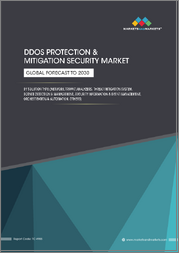
|
시장보고서
상품코드
1800830
보안 어플라이언스 시장 보고서 : 유형별, 배포별, 최종사용자별, 업계별, 지역별(2025-2033년)Security Appliances Market Report by Type (Firewall, Unified Threat Management, Intrusion Detection and Prevention, Content Management, Virtual Private Network, and Others), Deployment, End User, Vertical, and Region 2025-2033 |
||||||
세계 보안 어플라이언스 시장 규모는 2024년 1,458억 달러에 달할 것으로 예측됩니다. 향후 IMARC Group은 2033년에는 3,703억 달러에 달할 것으로 예상하며, 2025-2033년 연평균 성장률(CAGR)은 10.37%를 보일 것으로 전망합니다.
보안 어플라이언스는 네트워크 관리 및 보안에 사용되는 다양한 툴, 장비, 관행을 말합니다. 이러한 툴은 프라이빗 네트워크에 대한 무단 액세스를 방지하고 데이터 보안을 극대화하기 위해 기업에서 온클라우드 또는 온사이트에 도입합니다. 일반적으로 사용되는 보안 어플라이언스에는 방화벽, 침입 감지 및 방지 시스템, 컨텐츠 관리, 통합 위협 관리, 가상사설망(VPN) 등이 있습니다. 이러한 툴은 네트워크가 침해되는 것을 방지하기 위해 예방적이고 즉각적인 방법을 사용하며, 웹 필터링, 레거시 멀웨어 보호, 고급 위협 방어 시스템을 이용하여 인터넷을 통한 위협으로부터 네트워크를 보호합니다. 이러한 장점으로 인해 보안 어플라이언스는 은행, 금융서비스 및 보험(BFSI), 국방, 정보기술(IT), 헬스케어 등 다양한 산업에서 활용되고 있습니다.
보안 어플라이언스 시장 동향
세계에서 사이버 위협과 보안 침해가 증가하고 있는 것이 시장 성장을 가속하는 주요 요인 중 하나입니다. 조직은 사이버 피싱, 웹 해킹, 해킹, 사이버 스파이 행위로부터 기밀 데이터를 보호하기 위해 비용 효율적이고 효율적인 메커니즘을 채택하고 있습니다. 또한 조직 전반에 걸쳐 BYOD(Bring Your Own Device)가 확산되고 있는 점도 시장 성장을 촉진하고 있습니다. 이러한 추세로 인해 조직과 개인은 스마트폰, 태블릿, 노트북을 통해 악성코드와 위협에 쉽게 노출되고 있습니다. 이에 따라 클라우드 기반 솔루션의 채택이 증가하고 있는 것도 시장 성장에 기여하고 있습니다. 보안 어플라이언스와 클라우드 컴퓨팅의 통합으로 데이터 저장의 효율화, 서버에 대한 원격 접속, 패턴 감지를 위한 분석이 가능해지면서 이러한 어플라이언스 수요 증가에 기여하고 있습니다. 보다 광범위하고 기능적인 보안 어플라이언스의 개발 등 다양한 기술 발전도 시장 전망을 밝게 하는 요인 중 하나입니다.
이 보고서에서 다룬 주요 질문
- 2024년 세계 보안 어플라이언스 시장 규모는?
- 2025-2033년 세계 보안 어플라이언스 시장 성장률 전망은?
- 세계 보안 어플라이언스 시장을 촉진하는 주요 요인은 무엇인가?
- COVID-19가 세계 보안 어플라이언스 시장에 미치는 영향은?
- 세계 보안 어플라이언스 시장 유형별 분류는?
- 세계 보안 어플라이언스 시장의 전개 현황은?
- 세계 보안 어플라이언스 시장의 최종사용자별 시장 현황은?
- 세계 보안 어플라이언스 시장의 산업별 분류는?
- 세계 보안 어플라이언스 시장의 주요 지역은?
- 세계 보안 어플라이언스 시장의 주요 기업은?
목차
제1장 서문
제2장 조사 범위와 조사 방법
- 조사의 목적
- 이해관계자
- 데이터 소스
- 1차 정보
- 2차 정보
- 시장 추정
- 보텀업 어프로치
- 톱다운 어프로치
- 조사 방법
제3장 개요
제4장 서론
제5장 세계의 보안 어플라이언스 시장
- 시장 개요
- 시장 실적
- COVID-19의 영향
- 시장 예측
제6장 시장 내역 : 유형별
- 방화벽
- 통합 위협 관리(UTM)
- 침입 탐지 및 방지(IDP)
- 컨텐츠 관리
- 가상사설망(VPN)
- 기타
제7장 시장 내역 : 배포별
- 클라우드 기반
- 온프레미스
제8장 시장 내역 : 최종사용자별
- 중소기업
- 대기업
제9장 시장 내역 : 업계별
- BFSI
- 헬스케어
- IT·통신
- 소매
- 에너지·유틸리티
- 제조
- 기타
제10장 시장 내역 : 지역별
- 북미
- 미국
- 캐나다
- 아시아태평양
- 중국
- 일본
- 인도
- 한국
- 호주
- 인도네시아
- 기타
- 유럽
- 독일
- 프랑스
- 영국
- 이탈리아
- 스페인
- 러시아
- 기타
- 라틴아메리카
- 브라질
- 멕시코
- 기타
- 중동 및 아프리카
제11장 SWOT 분석
제12장 밸류체인 분석
제13장 Porter's Five Forces 분석
제14장 가격 분석
제15장 경쟁 구도
- 시장 구조
- 주요 기업
- 주요 기업의 개요
- Bosch Sicherheitssysteme GmbH(Robert Bosch GmbH)
- Check Point Software Technologies
- Cisco Systems Inc.
- Fortinet Inc.
- Hewlett Packard Enterprise Company
- Honeywell International Inc.
- Intel Corporation
- Juniper Networks Inc.
- NortonLifeLock Inc.
- Palo Alto Networks Inc.
- Trend Micro Inc.
The global security appliances market size reached USD 145.8 Billion in 2024. Looking forward, IMARC Group expects the market to reach USD 370.3 Billion by 2033, exhibiting a growth rate (CAGR) of 10.37% during 2025-2033.
Security appliances refer to various tools, equipment and practices used for network management and security. They are deployed on-cloud or on-site by organizations to prevent unauthorized access to private networks and maximize data security. Some of the commonly used security appliances include firewalls and systems for intrusion detection and prevention, content management, unified threat management and virtual private network (VPN). These tools use preventive and responsive methods to defend networks from being compromised and utilize web filtering, legacy malware protection and advanced threat defense systems to protect against internet-borne threats. Owing to these benefits, security appliances find applications across various industries, such as banking, financial services and insurance (BFSI), defense, information technology (IT) and healthcare.
Security Appliances Market Trends:
The increasing number of cyber threats and security breaches across the globe is one of the key factors driving the growth of the market. Organizations are adopting cost-effective and efficient mechanisms to protect sensitive data from cyber phishing, web hacking, hacktivism and cyber spying. Furthermore, the increasing trend of bring-your-own-devices (BYOD) across organizations is also augmenting the market growth. This trend has made organizations and individuals more vulnerable to malware and threats through smartphones, tablets and laptops. In line with this, the increasing adoption of cloud-based solutions is also contributing to the market growth. The integration of security appliances with cloud computing aids in streamlining the storage of data, accessing servers remotely and conducting analytics for pattern detection, which is contributing to the increasing demand for these appliances. Various technological advancements, such as the development of security appliances with improved range and capabilities, are some of the other factors creating a positive outlook for the market.
Key Market Segmentation:
Breakup by Type:
- Firewall
- Unified Threat Management (UTM)
- Intrusion Detection and Prevention (IDP)
- Content Management
- Virtual Private Network (VPN)
- Others
Breakup by Deployment:
- Cloud-based
- On-premises
Breakup by End User:
- Small and Medium Enterprises
- Large Organizations
Breakup by Vertical:
- BFSI
- Healthcare
- IT and Telecom
- Retail
- Energy and Utilities
- Manufacturing
- Others
Breakup by Region:
- North America
- United States
- Canada
- Asia Pacific
- China
- Japan
- India
- South Korea
- Australia
- Indonesia
- Others
- Europe
- Germany
- France
- United Kingdom
- Italy
- Spain
- Russia
- Others
- Latin America
- Brazil
- Mexico
- Others
- Middle East and Africa
Competitive Landscape:
The report has also analysed the competitive landscape of the market with some of the key players being Bosch Sicherheitssysteme GmbH (Robert Bosch GmbH), Check Point Software Technologies, Cisco Systems Inc., Fortinet Inc., Hewlett Packard Enterprise Company, Honeywell International Inc., Intel Corporation, Juniper Networks Inc., NortonLifeLock Inc., Palo Alto Networks Inc. and Trend Micro Inc.
Key Questions Answered in This Report
- 1.What was the size of the global security appliances market in 2024?
- 2.What is the expected growth rate of the global security appliances market during 2025-2033?
- 3.What are the key factors driving the global security appliances market?
- 4.What has been the impact of COVID-19 on the global security appliances market?
- 5.What is the breakup of the global security appliances market based on the type?
- 6.What is the breakup of the global security appliances market based on the deployment?
- 7.What is the breakup of the global security appliances market based on end user?
- 8.What is the breakup of the global security appliances market based on the vertical?
- 9.What are the key regions in the global security appliances market?
- 10.Who are the key players/companies in the global security appliances market?
Table of Contents
1 Preface
2 Scope and Methodology
- 2.1 Objectives of the Study
- 2.2 Stakeholders
- 2.3 Data Sources
- 2.3.1 Primary Sources
- 2.3.2 Secondary Sources
- 2.4 Market Estimation
- 2.4.1 Bottom-Up Approach
- 2.4.2 Top-Down Approach
- 2.5 Forecasting Methodology
3 Executive Summary
4 Introduction
- 4.1 Overview
- 4.2 Key Industry Trends
5 Global Security Appliances Market
- 5.1 Market Overview
- 5.2 Market Performance
- 5.3 Impact of COVID-19
- 5.4 Market Forecast
6 Market Breakup by Type
- 6.1 Firewall
- 6.1.1 Market Trends
- 6.1.2 Market Forecast
- 6.2 Unified Threat Management (UTM)
- 6.2.1 Market Trends
- 6.2.2 Market Forecast
- 6.3 Intrusion Detection and Prevention (IDP)
- 6.3.1 Market Trends
- 6.3.2 Market Forecast
- 6.4 Content Management
- 6.4.1 Market Trends
- 6.4.2 Market Forecast
- 6.5 Virtual Private Network (VPN)
- 6.5.1 Market Trends
- 6.5.2 Market Forecast
- 6.6 Others
- 6.6.1 Market Trends
- 6.6.2 Market Forecast
7 Market Breakup by Deployment
- 7.1 Cloud-based
- 7.1.1 Market Trends
- 7.1.2 Market Forecast
- 7.2 On-premises
- 7.2.1 Market Trends
- 7.2.2 Market Forecast
8 Market Breakup by End User
- 8.1 Small and Medium Enterprises
- 8.1.1 Market Trends
- 8.1.2 Market Forecast
- 8.2 Large Organizations
- 8.2.1 Market Trends
- 8.2.2 Market Forecast
9 Market Breakup by Vertical
- 9.1 BFSI
- 9.1.1 Market Trends
- 9.1.2 Market Forecast
- 9.2 Healthcare
- 9.2.1 Market Trends
- 9.2.2 Market Forecast
- 9.3 IT and Telecom
- 9.3.1 Market Trends
- 9.3.2 Market Forecast
- 9.4 Retail
- 9.4.1 Market Trends
- 9.4.2 Market Forecast
- 9.5 Energy and Utilities
- 9.5.1 Market Trends
- 9.5.2 Market Forecast
- 9.6 Manufacturing
- 9.6.1 Market Trends
- 9.6.2 Market Forecast
- 9.7 Others
- 9.7.1 Market Trends
- 9.7.2 Market Forecast
10 Market Breakup by Region
- 10.1 North America
- 10.1.1 United States
- 10.1.1.1 Market Trends
- 10.1.1.2 Market Forecast
- 10.1.2 Canada
- 10.1.2.1 Market Trends
- 10.1.2.2 Market Forecast
- 10.1.1 United States
- 10.2 Asia Pacific
- 10.2.1 China
- 10.2.1.1 Market Trends
- 10.2.1.2 Market Forecast
- 10.2.2 Japan
- 10.2.2.1 Market Trends
- 10.2.2.2 Market Forecast
- 10.2.3 India
- 10.2.3.1 Market Trends
- 10.2.3.2 Market Forecast
- 10.2.4 South Korea
- 10.2.4.1 Market Trends
- 10.2.4.2 Market Forecast
- 10.2.5 Australia
- 10.2.5.1 Market Trends
- 10.2.5.2 Market Forecast
- 10.2.6 Indonesia
- 10.2.6.1 Market Trends
- 10.2.6.2 Market Forecast
- 10.2.7 Others
- 10.2.7.1 Market Trends
- 10.2.7.2 Market Forecast
- 10.2.1 China
- 10.3 Europe
- 10.3.1 Germany
- 10.3.1.1 Market Trends
- 10.3.1.2 Market Forecast
- 10.3.2 France
- 10.3.2.1 Market Trends
- 10.3.2.2 Market Forecast
- 10.3.3 United Kingdom
- 10.3.3.1 Market Trends
- 10.3.3.2 Market Forecast
- 10.3.4 Italy
- 10.3.4.1 Market Trends
- 10.3.4.2 Market Forecast
- 10.3.5 Spain
- 10.3.5.1 Market Trends
- 10.3.5.2 Market Forecast
- 10.3.6 Russia
- 10.3.6.1 Market Trends
- 10.3.6.2 Market Forecast
- 10.3.7 Others
- 10.3.7.1 Market Trends
- 10.3.7.2 Market Forecast
- 10.3.1 Germany
- 10.4 Latin America
- 10.4.1 Brazil
- 10.4.1.1 Market Trends
- 10.4.1.2 Market Forecast
- 10.4.2 Mexico
- 10.4.2.1 Market Trends
- 10.4.2.2 Market Forecast
- 10.4.3 Others
- 10.4.3.1 Market Trends
- 10.4.3.2 Market Forecast
- 10.4.1 Brazil
- 10.5 Middle East and Africa
- 10.5.1 Market Trends
- 10.5.2 Market Breakup by Country
- 10.5.3 Market Forecast
11 SWOT Analysis
- 11.1 Overview
- 11.2 Strengths
- 11.3 Weaknesses
- 11.4 Opportunities
- 11.5 Threats
12 Value Chain Analysis
13 Porters Five Forces Analysis
- 13.1 Overview
- 13.2 Bargaining Power of Buyers
- 13.3 Bargaining Power of Suppliers
- 13.4 Degree of Competition
- 13.5 Threat of New Entrants
- 13.6 Threat of Substitutes
14 Price Analysis
15 Competitive Landscape
- 15.1 Market Structure
- 15.2 Key Players
- 15.3 Profiles of Key Players
- 15.3.1 Bosch Sicherheitssysteme GmbH (Robert Bosch GmbH)
- 15.3.1.1 Company Overview
- 15.3.1.2 Product Portfolio
- 15.3.2 Check Point Software Technologies
- 15.3.2.1 Company Overview
- 15.3.2.2 Product Portfolio
- 15.3.2.3 Financials
- 15.3.2.4 SWOT Analysis
- 15.3.3 Cisco Systems Inc.
- 15.3.3.1 Company Overview
- 15.3.3.2 Product Portfolio
- 15.3.3.3 Financials
- 15.3.3.4 SWOT Analysis
- 15.3.4 Fortinet Inc.
- 15.3.4.1 Company Overview
- 15.3.4.2 Product Portfolio
- 15.3.4.3 Financials
- 15.3.4.4 SWOT Analysis
- 15.3.5 Hewlett Packard Enterprise Company
- 15.3.5.1 Company Overview
- 15.3.5.2 Product Portfolio
- 15.3.5.3 Financials
- 15.3.5.4 SWOT Analysis
- 15.3.6 Honeywell International Inc.
- 15.3.6.1 Company Overview
- 15.3.6.2 Product Portfolio
- 15.3.6.3 Financials
- 15.3.6.4 SWOT Analysis
- 15.3.7 Intel Corporation
- 15.3.7.1 Company Overview
- 15.3.7.2 Product Portfolio
- 15.3.7.3 Financials
- 15.3.7.4 SWOT Analysis
- 15.3.8 Juniper Networks Inc.
- 15.3.8.1 Company Overview
- 15.3.8.2 Product Portfolio
- 15.3.8.3 Financials
- 15.3.8.4 SWOT Analysis
- 15.3.9 NortonLifeLock Inc.
- 15.3.9.1 Company Overview
- 15.3.9.2 Product Portfolio
- 15.3.9.3 Financials
- 15.3.9.4 SWOT Analysis
- 15.3.10 Palo Alto Networks Inc.
- 15.3.10.1 Company Overview
- 15.3.10.2 Product Portfolio
- 15.3.10.3 Financials
- 15.3.11 Trend Micro Inc.
- 15.3.11.1 Company Overview
- 15.3.11.2 Product Portfolio
- 15.3.11.3 Financials
- 15.3.11.4 SWOT Analysis
- 15.3.1 Bosch Sicherheitssysteme GmbH (Robert Bosch GmbH)



















